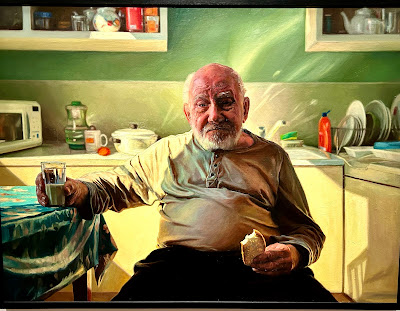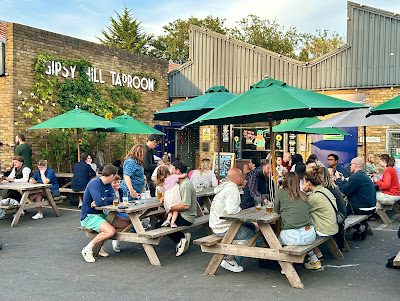 |
| Thames from Blackfriars Station |
 |
| Francis Crick Institute |
 |
| Chinatown |
 |
| Mo Mowlem in the National Portrait Gallery |
 |
| The Last Portrait by Sasha Sokolova in National Portrait Gallery |
 |
| Courtauld Institute - |
 |
| Van Gough's Presidential pose |
 |
| Local breweries are flourishing in London. |
Three days after walking out and about in Paris, I was back in London and had some free time. I am no plongeur but I decided to do the same in Central London. The days were perfect with the late August sunshine having lost its midsummer heat and humidity. I had walked 29,000 steps in Paris and I managed 23,000 in London where I spent more time visiting museums that were either built in the days of the old empire or erected as symbols of the new digital London. As in Paris, I had no preconceived plan but followed my instincts, taking in any scene or building that tickled my fancy. It was a good way to compare Europe's two great capital cities.
I caught a train to St Pancras, not from Paris but from Tulse Hill in South London. I chose St Pancras because it is one of my favourite buildings that was rescued from demolition by the Poet Laureate, Sir John Betjeman. The red brick Gothic Hotel that fronts the station was designed by the Victorian architect Sir George Gilbert Scott and the massive cast iron vaulted roof was the largest in the world when it was built. St Pancras like most of London's buildings had suffered from smoke, fog and underinvestment after the war and, unlike Paris, demolition and replacement by commercial retail and office blocks were the modus operandi of developers. The outcomes were dire and whilst there have been many remarkable buildings constructed in the past twenty or thirty years, London is a smorgasbord of architectural styles whereas Paris has retained most of the buildings that Hausmann incorporated within the planned development of the core of the city in the nineteenth century. The lack of high-rise buildings makes Paris more uplifting than the chaotic mix of new and old and low and high buildings in London on a street pattern that evolved over the centuries with no overriding design.
I visited one of the new buildings across the road from St Pancras, the Francis Crick Institute and looked at an exhibition of the workings of the brain. A massive foyer extended upwards with the innards of the lift system revealing a glass roof that flooded the building with light. The coffee was bland unlike the cafe coffee in Paris which is freshly ground, served quick and enjoyed slowly as you observe the street life. I continued to the British Library and joined so that I could look up a review for a robot mower in Which Magazine. After finding the right floor and section, I had to queue to make my request. Ten minutes later I was told that they didn't have the recent edition I requested because they had not yet re-ordered the magazine twelve months after the cyber attack crashed the system. It was a different reason than Lambeth Library had given me the day before when I had made the same request, they had not renewed membership of Which as part of their austerity savings. Still, I managed to have a good look around the library.
I walked to Tottenham Court Road and the retail areas and pottered around some furniture shops before seeking somewhere to eat. The number of homeless people in tents and empty shop entrances was far higher than I had noticed before and the homeless seemed a lot younger. The pubs were too McPuby, the sandwich bars were overcrowded and the restaurants too expensive for lunch so I drifted into John Lewis so I could have a look at some trail shoes and furniture and grab a quick meal and a sit-down. I have occasionally bumped into long-lost colleagues and friends here so I always keep a sharp eye for people who may now be thirty or forty years older than our last acquaintance. It can be one of life's pleasures to meet someone from the distant past and discover the bones of their life's journey.
The afternoon began with a jaunt down Oxford Street and Regent Street. As I approached Trafalgar Square, I was tempted to spend some time in the National Portrait Gallery, a place that never disappoints. I was greatly taken by John Keane's portrait of Mo Mowlem and enjoyed the 2024 Portrait Annual Award exhibits, there is a people's award ao I voted for Aleksandra Sokolova's portrait of her elderly father who had also been an artist..
I meandered through Chinatown towards Covent Garden and called in at the hotel where Aileen and I had stayed for her 70th birthday on our last trip to London together. It had been a perfect weekend and I wanted to recapture the memory. I had never managed to visit Somerset House so I dropped down to the embankment and walked along past the solid sandstone buildings that were built in Victorian times. The traffic was heavy, although most of the cabs are electric nowadays. The bar outside Somerset House in full swing with lots of office workers taking a late lunch or swanning off early to steal a bit of the summer that had only just turned up. I walked through the courtyard where children were running through the fountains and found the entrance to the Courtauld Institute. I climbed the three flights of stairs to the Impressionist room and spent half an hour in a near-empty gallery admiring the fine collection. I was amused to see Van Gogh's self-impression of the Trump assassination attempt, the bandaging of the ear was far better than the Trumpian swab.
It was time to head home and I decided to travel from Blackfriars Station. Its platforms are on the bridge over the Thames and provide an amazing view of the city skyline and the boats on the Thames. On the train home and later as I relaxed with family in an outside bar attached to the local brewery, I tried to draw some reflections from my time out and about in Paris and London.
The Thames is wider and murkier than the Seine and it seems to divide the city into north and south. There are many bridges but mainly for rail and traffic. Whereas the Seine seems to unite the right and left banks by numerous bridges some of which have been pedestrianised and provide public spaces where people do yoga and other workouts. London's South Bank is an attraction in itself but it seems a distant add-on to the central area apart from where the Millennium pedestrian bridge links across to the Tate Modern.
Paris was more tranquil and quieter despite the wonderfully executed 2024 Olympic and Paralympic Games but Paris is always empty of many of its residents in August. Paris seemed full of Americans and visitors from the rest of Europe. London was hoaching with tourists at the end of the school holidays with visitors from all over the globe, particularly from the developed Asian countries. Parisians seemed more laid back as they glided around their city with restful cafes and independent shops always on hand, Londoners seemed more on edge as they dodged the traffic, queued for lunch and shopped in the mainly franchised stores
London had many areas where mini campsites had grown for those sleeping rough. Paris seems different although there were stories about shipping out rough sleepers for the duration of the Olympics.
London has a better range of museums, and cultural and sports stadiums to visit but Paris has the intimacy and charm of its cafe culture.
As a visitor, prices appeared cheaper in Paris for food, drink and clothing. Train fares are certainly a lot cheaper but rail travel in both cities was working well. If you throw housing and other services into the equation, various studies have found that Paris is 15 -20% cheaper to live in than London. Housing and travel are the main areas of difference.
On architecture and urban design, Paris wins hands down but the often eccentric new buildings in London have created a skyline of modern art and the fine adaptions of old buildings like power stations and railway buildings (King's Cross) provide examples of less coherent but more imaginative buildings. Paris does this less often and even the Pompidou Centre and the new Westfield shopping centre at Les Halles which has 3 floors underground do not break the symmetry of the city centre skyline.
In short, Paris slows you down and London pumps you up. They are both successful world cities adapting in different ways to retain their primacy in countries of comparable size and lingering self-importance. In this respect, they have hollowed out the investment in other cities by their agglomeration of political, cultural, academic, financial and sporting activities. Other European cities do not have the same level of primacy which is why Munich, Barcelona, Milan and other non-capital cities provide alternative nodes for the economic well-being and equality in their countries. Devolution in the time of primacy is a necessary condition for sustainable development.

No comments:
Post a Comment
thanks